Publications Search
This publications portal is a repository of all IOM migration health publications from 2006 to present where IOM was a primary contributor.
Publications include peer-reviewed scientific papers, technical reports, training guides/manuals, policy briefs/discussion papers, factsheets, newsletters, research reviews, conference and poster presentations. These are categorized by topic, author, country/region covered as well as by year, language, and type of publication. The map reflects the countries covered by the publications.
To browse or search: simply use the filter options on the left-hand side. Alternatively, you can enter keyword/s in the search box. Selecting a specific publication will lead to a ‘download’ link or link to the website where the document is housed. Here is the step-by-step guide for your reference.
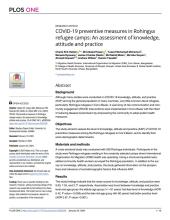
COVID-19 preventive measures in Rohingya refugee camps: An assessment of knowledge, attitude and practice
Author/s: Charls Erik Halder, Md Abeed Hasan, Yussuf Mohamed Mohamud, Marsela Nyawara, James Charles Okello, Md Nahid Mizan, Md Abu Sayum, Ahmed Hossain, Andrew Willam, Hamim Tassdik
Background
Although many studies were conducted on COVID-19 knowledge, attitude, and practice (KAP) among the general population in many countries, very little is known about refugees, particularly Rohingya refugees in Cox’s Bazar. A vast array of risk communication and community engagement (RCCE) interventions were implemented in Cox’s Bazar with the intent of reducing disease transmission by empowering the community to adopt public health measures.
Objectives…
Read more
Understanding the challenges and gaps in community engagement interventions for COVID-19 prevention strategies in Rohingya refugees: a qualitative study with frontline workers and community representatives
Author/s: Charls Erik Halder, Md Abeed Hasan, Yussuf Mohamed Mohamud, Marsela Nyawara, James Charles Okello, Md Nahid Mizan, Md Abu Sayum, Ahmed Hossain
Background: Rohingya refugees in Bangladesh are vulnerable to infectious diseases such as COVID-19 due to the crowded living conditions with fragile shelters, and limited water, sanitation and hygiene facilities and practices. While risk communication and community engagement (RCCE) is the cornerstone of outbreak control, there is limited evidence available on the effectiveness of the RCCE strategies in this setting.
Objectives: The goal of this study is to evaluate…
Read more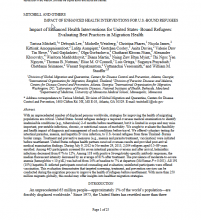
Impact of enhanced health interventions for United States–bound refugees: Evaluating best practices in migration health
Author/s: Tarissa Mitchell, Deborah Lee, Michelle Weinberg, Christina Phares, Nicola James, Kittisak Amornpaisarnloet, Lalita Aumpipat, Gretchen Cooley, Anita Davies, Valerie Daw Tin Shwe, Vasil Gajdadziev, Olga Gorbacheva, Chutharat Khwan-Niam, Alexander Klosovsky, Waritorn Madilokkowit, Diana Martin, Naing Zaw Htun Myint, Thi Ngoc Yen Nguyen, Thomas Nutman, Elise O’Connell, Luis Ortega, Sugunya Prayadsab, Chetdanai Srimanee, Wasant Supakunatom, Vattanachai Vesessmith, William Stauffer
With an unprecedented number of displaced persons worldwide, strategies for improving the health of migrating populations are critical. United States–bound refugees undergo a required overseas medical examination to identify inadmissible conditions (e.g., tuberculosis) 2–6 months before resettlement, but it is limited in scope and may miss important, preventable infectious, chronic, or nutritional causes of morbidity. We sought to evaluate the feasibility and health impact…
Read more
Health status of returning refugees, internally displaced persons, and the host community in a post-conflict district in northern Sri Lanka: a cross-sectional survey
Author/s: Rachel Burns, Kolitha Wickramage, Anwar Musah, Chesmal Siriwardhana, Francesco Checchi
Abstract
Background Although the adverse impacts of conflict-driven displacement on health are well-documented, less is known about how health status and associated risk factors differ according to displacement experience. This study quantifies health status and quality of life among returning refugees, internally displaced persons, and the host community in a post-conflict district in Northern Sri Lanka, and explores associated risk factors.
…
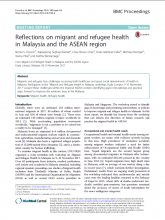
Reflections on migrant and refugee health in Malaysia and the ASEAN region
Author/s: Nicola Pocock, Rapeepong Suphanchaimat, Chee Khoon Chan, Erwin Martinez Faller, Nicholas Harrigan, Veena Pillai, Kolitha Wickramage
Migrants and refugees face challenges accessing both healthcare and good social determinants of health in Malaysia. Participants at the “Migrant and Refugee Health in Malaysia workshop, Kuala Lumpur, 9-10 November 2017” scoped these challenges within the regional ASEAN context, identifying gaps in knowledge and practical steps forward to improve the evidence base in the Malaysia.
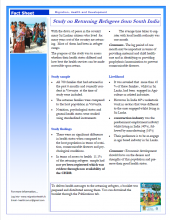
Study on returning refugees from South India
Author/s: IOM Sri Lanka
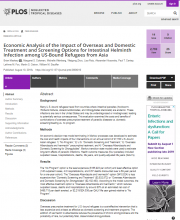
Economic Analysis of the Impact of Overseas and Domestic Treatment and Screening Options for Intestinal Helminth Infection among US-Bound Refugees from Asia
Author/s: Brian Maskery, Margaret S. Coleman, Michelle Weinberg, Weigong Zhou, Lisa Rotz, Alexander Klosovsky, Paul T. Cantey, LeAnne M. Fox, Martin S. Cetron, William M. Stauffer
BACKGROUND: Many U.S.-bound refugees travel from countries where intestinal parasites (hookworm, Trichuris trichuria, Ascaris lumbricoides, and Strongyloides stercoralis) are endemic. These infections are rare in the United States and may be underdiagnosed or misdiagnosed, leading to potentially serious consequences. This evaluation examined the costs and benefits of combinations of overseas presumptive treatment of parasitic diseases vs. domestic screening/treating vs. no program.
…
Read more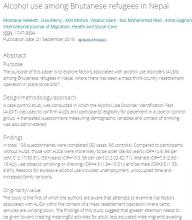
Alcohol use among Bhutanese refugees in Nepal
Author/s: Montana Hewlett, Lisa Merry, Anit Mishra, Risatul Islam, Raz Mohammad Wali, Anita Gagnon
The purpose of this paper is to explore factors associated with alcohol use disorders (AUDs) among Bhutanese refugees in Nepal, where there has been a mass third-country resettlement operation in place since 2007.

Nutrition Surveillance Report (Issue No. 4, January–December 2013)
Author/s: IOM
This report presents child growth and malnutrition status of refugee children examined by the IOM Health Assessment Programme at select locations namely Ethiopia, Iraq, Jordan, Kenya, Malaysia, Nepal, Thailand, Rwanda, South Africa and Uganda. The report analyses prevalence of three key indicators for protein–energy malnutrition, namely, weight-for-height or wasting, height-for-age or stunting, and weight-for-age or underweight. Data for this analysis is generated from the…
Read more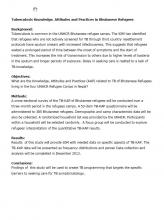
Tuberculosis Knowledge, Attitudes, and Practices in Bhutanese Refugees
Author/s: IOM Nepal
Tuberculosis is common in the UNHCR Bhutanese refugee camps. The IOM has identified that refugees who are not actively screened for TB through third country resettlement protocols have sputum smears with increased infectiousness. This suggests that refugees waited a prolonged period of time between the onset of symptoms and the start of treatment. This increases the risk of transmission to others due to higher levels of bacteria in the sputum and longer periods of exposure. Delay in seeking…
Read more